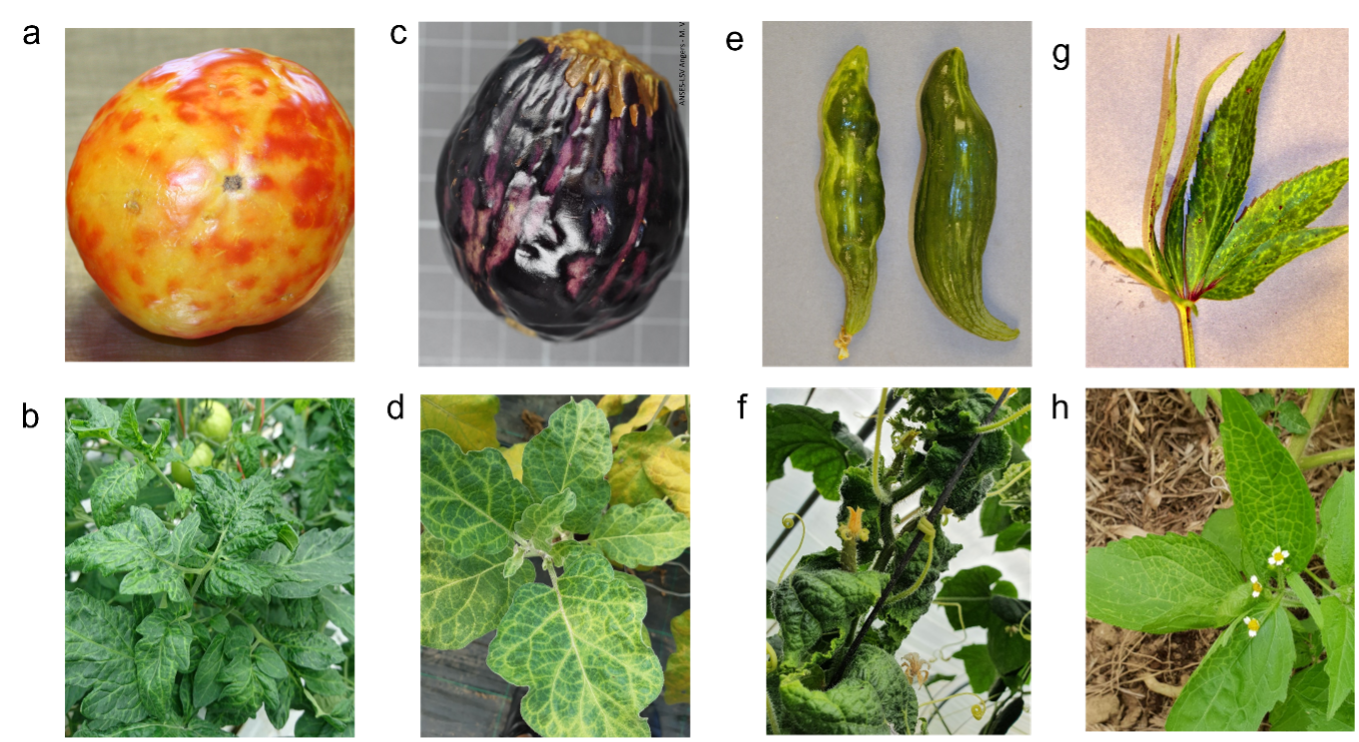BIOLOGICAL AND GENETIC CHARACTERIZATION OF PHYSOSTEGIA CHLOROTIC MOTTLE VIRUS IN EUROPE BASED ON HOST RANGE, LOCATION, AND TIME
Coline Temple1, Arnaud G. Blouin1,9, Kris De Jonghe2, Yoika Foucart2, Marleen Botermans3, Marcel Westenberg3, Ruben Schoen3, Pascal Gentit4, Michèle Visage4, Eric Verdin5, Catherine Wipf-Scheibel5, Heiko Ziebell6, Yahya Z. A. Gaafar6, Amjad Zia6, Xiao-Hua Yan6, Katja R. Richert-Pöggeler6, Roswitha Ulrich7, Mark Paul S. Rivarez8, Denis Kutnjak8, Ana Vučurović8, Sébastien Massart1* https://doi.org/10.1094/PDIS-12-21-2800-RE We report here how prepublication datasharing resulted in an international collaboration across eight laboratories in five countries, enabling an in-depth characterization of Physostegia chlorotic mottle virus (PhCMoV). In this study, we highlight the first detection of the virus in six European countries and in seven new natural host plants. Our research established that PhCMoV is associated with severe symptoms and the additional 21 generated sequences allowed to study its phylogeny across time and geographic locations.
- 23 January 2023
- Yolanda Hernando Saiz
- < back to blog index
Application of high throughput sequencing (HTS) technologies enabled the first identification of Physostegia chlorotic mottle virus (PhCMoV) in 2018 in Austria. Subsequently, PhCMoV was detected in Germany and Serbia on tomatoes showing severe fruit mottling and ripening anomalies. We report here how prepublication datasharing resulted in an international collaboration across eight laboratories in five countries, enabling an in-depth characterization of PhCMoV. The independent studies converged toward its recent identification in eight additional European countries and confirmed its presence in samples collected 20 years ago (2002). The natural plant host range was expanded from two to nine species across seven families, and we confirmed the association of PhCMoV presence with severe fruit symptoms on economically important crops such as tomato, eggplant, and cucumber. Mechanical inoculations of selected isolates in the greenhouse established the causality of the symptoms on a new indexing host range. In addition, phylogenetic analysis showed a low genomic variation across the 29 near-complete genome sequences available. Furthermore, a strong selection pressure within a specific ecosystem was suggested by nearly identical sequences recovered from different host plants through time. Overall, this study describes the European distribution of PhCMoV on multiple plant hosts, including economically important crops on which the virus can cause severe fruit symptoms. This work demonstrates how to efficiently improve knowledge on an emergent pathogen by sharing HTS data and provides a solid knowledge foundation for further studies on plant rhabdoviruses.

< back to blog index
Recent posts
- Carrot populations in France and Spain host a complex virome rich in previously uncharacterized viruses
- VIROME ANALYSIS OF IRRIGATION WATER SOURCES PROVIDES EXTENSIVE INSIGHTS INTO THE DIVERSITY AND DISTRIBUTION OF PLANT VIRUSES IN AGROECOSYSTEMS
- Round table: https://youtu.be/XPYOCrXqqOQ
- Managing the deluge of newly discovered plant viruses and viroids: an optimized scientific and regulatory framework for their characterization and risk analysis
- A new flavi-like virus identified in populations of wild carrot
- Tomato brown rugose fruit virus in aqueous environments – survival and significance of water-mediated transmission
- First report of carrot torrado virus 1 (CaTV1) naturally infecting carrots in Spain
- VirHunter: A Deep Learning-Based Method for Detection of Novel RNA Viruses in Plant Sequencing Data
- Diversity of polerovirus-associated RNAs in the virome of wild carrots
- First report of Apium virus Y in wild carrot (Daucus carota ssp. carota) in Spain
- Tobamoviruses show broad host ranges and little genetic diversity among four habitat types of a heterogeneous ecosystem.
- Metagenomics show high spatiotemporal virus diversity and ecological compartmentalisation: virus infections of melon, Cucumis melo, crops and adjacent wild communities
- Web-based roundtable: Adoption and impact of high throughput sequencing in plant health: Seed testing, surveillance and certification
- Identification of two novel putative satellite RNAs with hammerhead structures in the virome of French and Spanish carrot samples
- Diversity and pathobiology of an Ilarvirus unexpectedly detected in diverse plants and global sequencing data
- First Report of Ranunculus White Mottle Ophiovirus in Slovenia in Pepper with Yellow Leaf Curling Symptom and in Tomato
- In-depth study of tomato and weed viromes reveals undiscovered plant virus diversity in an agroecosystem
- THE EXPANDING MENAGERIE OF PRUNUS-INFECTING LUTEOVIRUSES
- Molecular characterization of a new Prunus-infecting cheravirus and complete genome sequence of stocky prune virus
- Genetic differentiation and migration fluxes of viruses from melon crops and crop edge weeds
- Global advances in tomato virome research: current status and the impact of high-throughput sequencing
- Cont-ID: Detection of samples cross-contamination in viral metagenomic data
- Validation of high throughput sequencing as virus indexing test for Musa germplasm: performance criteria evaluation and contamination monitoring using an alien control
- HIGH THROUGHPUT SEQUENCING TECHNOLOGIES COMPLEMENTED BY GROWER’S PERCEPTION HIGHLIGHT THE IMPACT OF TOMATO VIROME IN DIVERSIFIED VEGETABLE FARMS
- BIOLOGICAL AND GENETIC CHARACTERIZATION OF PHYSOSTEGIA CHLOROTIC MOTTLE VIRUS IN EUROPE BASED ON HOST RANGE, LOCATION, AND TIME
- Risk perception associated with an emerging agri-food risk in Europe: plant viruses in agriculture
- First reports of Apple luteovirus 1, Apple rubodvirus 1 and Apple hammerhead viroid infecting apples in Belgium
- Evaluation of Methods and Processing for Robust Monitoring of SARS-CoV-2 in Wastewater
- Importance of associated weeds and cropping systems in shaping the viromes of horticultural crops. Ayoub Maachi PhD Thesis
- Use of high throughput sequencing and two RNA input methods to identify viruses infecting tomato crops.
- Complete genome sequence of malva-associated soymovirus 1: a novel virus infecting common mallow
- Cohombrillo-associated virus: a novel virus infecting Ecballium elaterium plants
- Known and new viruses identified in the virome of crops scanned by INEXTVIR
- Scanning the virome of Prunus : Identification and characterization of novel luteoviruses and Secoviridae members
- Complete genome sequence of almond luteovirus 1, a novel luteovirus species infecting almond
- INEXTVIR Mid-Term Check + Network Meeting 2 + School 2